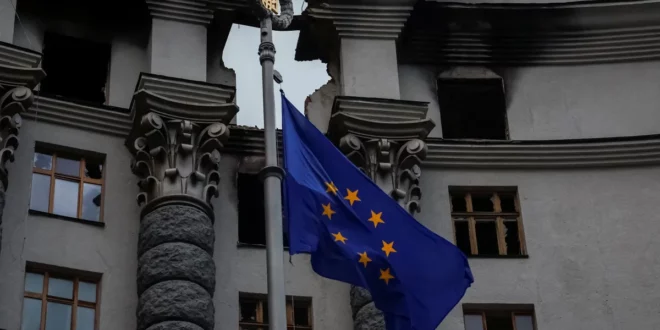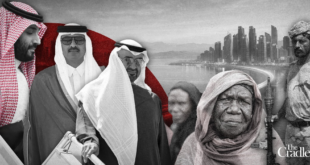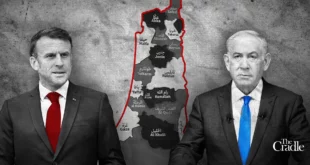A Plan to Beat the Kremlin on Its Own Terms
In the early hours of September 10, Polish and NATO forces shot down several of the 19 Russian drones estimated to have crossed into Polish airspace—an unprecedented incursion that caused consternation and alarm throughout Europe. Russia denied responsibility, implying that the drones had simply lost their way; NATO and European officials suggested the violation was intentional. Whatever the case, the clash marked the first time that NATO engaged enemies in allied territory. A few days later, another Russian drone moved into NATO airspace, this time over Romania, although the Romanians took no action and the drone eventually crossed into Ukraine. These events underline what remains a daunting prospect for Europeans: the possibility that the grinding war of attrition in Ukraine will spill over into a broader war between Europe and Russia.
Moscow’s evident determination to keep fighting in Ukraine has fueled mounting anxiety among European leaders. Since Donald Trump’s return to office, they have twisted themselves into diplomatic contortions to implore, indulge, and flatter the American president in the hopes of sustaining the White House’s engagement with the war in Ukraine and of keeping Russia at bay. Yet it was Russian President Vladimir Putin—the “ogre at the door,” as French President Emmanuel Macron once called him—who strolled down a red carpet, to Trump’s applause, before a bilateral summit in Alaska in August. The Europeans, who weren’t invited, turned to damage control. The following week, European leaders flew to Washington alongside Ukrainian President Volodymyr Zelensky to offer him support and show a united front against Russia. Trump treated his guests as he might contestants on The Apprentice: at once effusive, then dismissive, and always uncommitted. By the dismally low standards of current transatlantic relations, the meeting was a success only for ending without incident.
The latest round of U.S.-Russian pageantry was another reminder of what has long been clear: Europe’s security is being decided elsewhere. Caught between a revisionist Kremlin and an indifferent White House, Europe is consistently outmaneuvered and often marginalized. The European Union’s failure to shape global geopolitical outcomes stems from its own foreign policy incoherence, including a historic overreliance on the United States and an inability to develop a consistent strategy for dealing with Russia, its key adversary.
As a result, Putin has opted for endurance: outlasting Western support for Ukraine by exploiting transatlantic fatigue and pairing threats of escalation with the phantasm of a peace that is always just around the corner. Putin inflates modest battlefield gains into major victories and touts Russia’s overheated war economy as a sign of strength. His goals are clear: turn Ukraine into a truncated client state, fracture Western unity, and reshape the world order to support Russia’s long-term bid for imperial greatness. Europe, meanwhile, hopes that the United States will rediscover transatlantic solidarity or that Russia will simply stand down in Ukraine. Neither scenario is likely, and neither constitutes a strategy. What Europe needs is to confront the Kremlin on its own terms.
Europe must revise its approach to Russia to be more aggressive and calculating. It should use what economic tools it has available, such as the seizure of Russian assets abroad, to their fullest extent. At the same time, it should not take stringent positions that consign it to the sidelines of future negotiations—for instance, by refusing to countenance sanctions relief for Russia unless Ukraine is restored to its 1991 borders, a stance that means that Europe will not get a seat at the table. Europe should also learn to beat Putin at his own subversive game by encouraging both the defection of Russian elites and the flight of capital from Russia. European leaders should look ahead, as well, to a time beyond Putin—and lay the groundwork for that future relationship. If Europe wants to help shape Russia, it must start now. Otherwise, Russian drones over Poland and Romania may be a harbinger of a far more troubling future to come.
LAY OF THE LAND
After Russia’s full-scale invasion, Europe swiftly rallied to Ukraine’s aid, spending more than $200 billion to date on military assistance and economic aid. The EU has delivered 18 successive sanctions packages against Russia since the invasion began. It has also committed to enlarging the union to include Ukraine and Moldova, despite objections from Hungary, one of its member states.
Russian aggression and recent U.S. pressure have also prompted the EU to make smarter defense investments and build a stronger industrial base. The bloc established Security Action for Europe, a fund of 150 billion euros from which EU member states and several external partners, including Ukraine, can draw for defense procurement. New defense coproduction schemes, such as an agreement between Denmark and Ukraine, will also allow Europeans to build up military capabilities they will need for decades to come. On the whole, there is reason to be confident in Europe’s long-term ability to deter Russia. Despite current impediments—including bottlenecks in military production, uneven anti-drone and cyberwarfare capabilities among states, and gaps in intelligence-sharing—Europe could already sustain and win a conventional war with Russia should one break out.
European capabilities may be fairly strong, but Europe’s will is not. Countries lack the collective urgency to shape not only the endgame in Ukraine but also a larger idea of European security. There is certainly no consensus on how to respond to Russian provocations, as evidenced by the different reactions Poland and Romania had toward the drone threats. European states do not even have a shared understanding of what it would mean for Europe if Russia finally subdued Ukraine, either through an outright military victory or a settlement brokered on Putin’s terms.
One view, rarely voiced in public but quietly circulated in elite EU policy circles, is that such an outcome wouldn’t fundamentally change things for Europe. The continent could resume a limited relationship with Russia; after all, Europe bought oil and gas from the Soviet Union, which controlled Ukraine, and even signed arms control treaties with it—détentes propelled by the logic of Wandel durch Handel, West Germany’s “change through trade” policy toward communist states. Hungarian Prime Minister Viktor Orban and Slovakian Prime Minister Robert Fico espouse this attitude today. Far-right opposition forces in France, Germany, Italy, and Romania would also likely tilt these member states’ national policies toward rapprochement if they were to gain power. The logic of this position is simple: an antagonistic Russia is not going away and the risks of escalation are too high. It is, therefore, better to settle now. Europe should find a balance with an aggressive Russia through trade and concessions, even as Russia rebuilds an empire on Europe’s eastern frontier.
The alternative view is that an end to the war in Ukraine that favors Russia would pose an existential threat to the continent by leaving Europe’s eastern flank exposed to Russian subversion or even outright invasion. This line of thinking holds that it was naive to assume Putin would stop at Crimea in 2014 and that it is dangerous to assume he will stop at Ukraine now. It regards Russia’s demands that NATO retreat to its pre-1997 borders not as rhetorical bluff but as a maximalist goal Moscow will try to fulfill.
In visible disarray, the Europeans—notably the British and the French—have hammered together a so-called coalition of the willing to try to build consensus on Ukraine by circumventing Hungary and other dissenting countries. But there is little actual appetite for instituting any kind of European-led security guarantees. As Poland’s foreign minister, Radoslaw Sikorski, recently said, “Who wants to fight Russia? I don’t see many volunteers.” EU members have also been squabbling among themselves, as in a recent public spat between Poland and Hungary over Ukrainian attacks on the Druzhba oil pipeline, which delivers Russian oil to Hungary and Slovakia. Such bickering projects an image of a helpless Europe unable to speak with one voice. It also prevents Europe from using the significant tools already at its disposal.
For example, the Europeans have been unwilling to confiscate frozen Russian assets to raise more money for Ukraine, earning duplicitous praise from the Kremlin. They have also been generally unwilling to challenge Russian tankers that are smuggling oil to China and India to help fuel Moscow’s war economy. A leading EU member state, Germany, has been incomprehensibly reluctant to provide Ukraine with long-range missiles, while France has vaguely threatened to send ground troops to Ukraine even though it has no real intention of doing so. The Russian drone incursions into Poland and Romania have so far led to little more than statements of concern, instead of what it should have brought about: additional and very public commitments of significant military aid to Ukraine. As it is, Putin has every reason to doubt that further acts of Russian sabotage or subversion will provoke tangible consequences.
Europe has also failed on the diplomatic front by excluding itself from the negotiations process. With few exceptions, the Europeans have shunned direct contact with Russia, instead using long-range propaganda to show the Kremlin what they think of Putin’s brutal policies. Yet declaring Putin a war criminal—however justly—does not help in negotiating an end to the war. It also keeps the Europeans out of the rooms where such negotiations happen. As U.S. and Russian negotiators began meeting behind closed doors, in Alaska and elsewhere, the Europeans watched from the sidelines, unable to insert themselves into talks or offer viable alternatives to a Russian-designed peace in Ukraine and unwilling to use their economic leverage to force Putin into a dialogue.
Remarkably, they did so even as the Trump administration productively engaged with the EU’s neighbors, including Belarus, which is led by the Russian-backed dictator Alexander Lukashenko. Trump even brought Armenia and Azerbaijan together to sign a peace deal in the White House, without any Russian or European involvement. Just three years ago, Ursula von der Leyen, the president of the European Commission, had called Azerbaijan a “crucial energy partner.” That economic opening, however, was not matched by political follow-through. This lost opportunity to establish transactional ties with a country on Russia’s doorstep is symptomatic of the EU’s lack of pragmatism concerning the larger region. As Moscow’s grip loosens in its own backyard, Europe can step in with meaningful alternatives, exploiting tensions in Russia’s relations with its many unhappy neighbors and thus gaining ground in its geopolitical tug of war with the Kremlin.
Projecting European strength requires more than simply building up arms and offering Ukraine reassurances of future assistance. Europe must also start employing Putin’s own tactics against him. It must embrace its own campaign of subversion.
PLAYING BY THE RULES
One of the defining features of Russia’s economic collapse in the 1990s was a vast outflow of capital. By conservative estimates, more than $150 billion was moved to offshore accounts while ordinary Russians faced economic ruin. This propelled the country’s 1998 financial crisis, which further accelerated capital flight and resulted in domestic political chaos. Such turmoil in turn elevated Putin, who promised to restore stability, impose order, and rein in the oligarchs. Buoyed by soaring oil prices, Russia’s new leader rebuilt the economy and amassed a formidable war chest—one that now sustains his campaign in Ukraine and underwrites the resilience of his regime.
After the 2022 invasion of Ukraine, Russia shielded its economy by combining aggressive fiscal stimuli with strict controls, effectively preventing a mass exodus of capital. Russian oligarchs and businessmen also feared asset seizures abroad and so returned to Moscow’s protective fold. Putin welcomed them. “It’s safer at home,” he said, taunting those who had lost fortunes elsewhere as naive. “Invest here.” He branded those who moved capital abroad as “dangerous” to his regime. Some U.S. and European sanctions actually reinforced this fortress strategy by making it harder for Russians to transfer or shelter assets overseas. The result: Russia avoided the kind of balance-of-payments crisis that had crippled the state in the 1990s.
Europe should recognize that weakening the Kremlin’s war effort requires disrupting the internal equilibrium that sustains it. To this end, Europe needs to encourage elite defection and capital flight. This does not mean turning the continent into a safe haven for illicit wealth. Russian capital must be rigorously screened to ensure that it is not used to buy political influence. But creating selective exit ramps for regime insiders, as well as safe channels for moving their assets, can serve as a form of targeted subversion. The death in July of Russia’s transport minister, Roman Starovoit, officially ruled a suicide, points to the deepening paranoia and pressure within Russia’s ruling class. Europe must offer an escape hatch for those ready to abandon ship—and bring their knowledge and money with them. The goal is not to rehabilitate Russia’s weakening oligarchy but to fracture the elite networks that still play a significant role in sustaining Putin’s rule.
Europe must revise its approach to Russia to be more aggressive and calculating. Europe should also do more to attract Russian professionals ready to break rank, renounce their Russian citizenship, and resettle in Europe. Their departure would weaken the regime from within. Scientists, doctors, and IT specialists, for instance, form the backbone of the Russian war economy. By voting with their feet, they could drain talent, accelerate decay, and pressure the Kremlin to seal its borders—an act that would expose Putin’s authoritarianism and hasten his decline. Facilitating their exit would help unravel the domestic consensus sustaining the war.
A key argument against this approach is the risk of infiltration by Russian saboteurs and spies. But the threat is overstated: Russian intelligence operatives are already in Europe in significant numbers, and any further increase can be partially neutralized through better counterintelligence work and due diligence. It would come with manageable danger for Europe, but the potential effect on Russia’s already thinly stretched economy cannot be overstated.
The damage could be political as well as financial.By creating a haven so attractive that Putin is compelled to seal his borders and lock his citizens inside, Europe could expose his weakness. There is precedent for this. In the early Cold War, East Germany hemorrhaged skilled workers to the West, weakening the regime’s economic base. In response, the communist leadership built the Berlin Wall—a landmark that became an embodiment of failure, proof that the regime could survive only by imprisoning its own citizens. It helped delegitimize East German communism and paved the way for its eventual collapse. Likewise, Europe should make clear, through both policy and public messaging, that Putin’s war has severed Russia from the European idea, and that those willing to walk away from that war will find Europe open to them.
Paradoxically, European states could more easily coordinate and institute subversion tactics than make more conventional moves, such as imposing sanctions. This is because subversion relies on national competence, not EU unanimity, since many aspects of migration and border control can be reshaped through existing mechanisms without total consensus. Even skeptics such as Hungary or Slovakia can paint the selective intake of high-skill Russian workers and elites as a humanitarian, pro-growth measure rather than an escalation of hostilities.
WAR THEN PEACE
Any viable EU strategy toward Russia must incorporate a long-term vision for where Europe wants Russia to be in ten or 15 years—whether or not Putin remains in power. Without it, Europe risks locking itself into a purely confrontational stance in which it treats Russia as an eternal enemy.
After the fall of the Soviet Union, Europe was the strongest advocate for integrating Russia into international institutions and involving it in security collaboration with NATO. That tradition continued to guide EU engagement with Russia until the invasion of Ukraine, even when its members should have decided to change course. Yet it cannot now be replaced by a simplistic strategy of containment in which Europe keeps Russia in a bear cage and prods it from a safe distance. The goal must instead be to weaken and ultimately defeat an aggressive adversary while maintaining the possibility of Russia’s postimperial future.
If Europe succeeds in weakening the Kremlin, it will also bear some responsibility for managing the instability that follows. The EU’s Russia strategy should therefore include planning for Russia’s postconflict transition, when it may reintegrate with collaborative international frameworks with Western countries. Such a strategy will resist the temptation of fatalism. Russia is not destined to be hostile, undemocratic, or imperialist by nature. Even as Europe confronts Russian aggression with clarity and force, it must pursue a dual-track strategy—one that keeps the door open to a different relationship with the country. Europe can hold a dagger in one hand, but it must be prepared to extend the other.
 Eurasia Press & News
Eurasia Press & News



